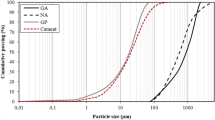Abstract
Glassy unsaturated polyester (UP) resin was reinforced using an organically modified montmorillonite (OMMT) and toughened with core–shell rubber (CSR) particles. The nanostructure, morphology, and deformation mechanism of composite specimens were studied by small-angle X-ray scattering (SAXS), transmission electron microscopy (TEM) and reflected optical microscopy (ROM). An intercalated nanostructure with partial exfoliation was observed in the UP reinforced by various amounts of OMMT. Locally clustered but globally good CSR particle dispersion in the UP matrix was evident in UP toughened with 5 and 10 wt% CSR particles. Simultaneous presence of OMMT and CSR particles in UP/OMMT/CSR hybrid composites was found to cause partial phase separation with bigger rubber particle agglomerates and lower clay-intergallery height increase. The effects of OMMT and CSR contents on volume shrinkage, impact fracture energy, fracture toughness, and compressive yield strength of UP were investigated. The introduction of OMMT of up to 3 wt% into the UP matrix lowered volume shrinkage to some extent, while further addition increased the shrinkage slightly. In the hybrid nanocomposites, the volume shrinkage decreased to a minimum level of 5.2 % with increases in OMMT level. The impact fracture energy of UP improved with increasing the OMMT level of up to 3 wt%, whereas its further addition decreased the impact fracture energy slightly due to the clay particle agglomeration. The hybrid composites with OMMT level below 3 wt% showed higher impact fracture energy compared to the reinforced UP specimens with the same OMMT levels. Interestingly, a synergism in the fracture toughness (K IC) was observed in the hybrid composite containing 1 wt% OMMT and 10 wt% CSR particles. The presence of OMMT as reinforcement in the hybrid composites could compensate the lowering of the compressive yield strength caused by low-modulus CSR particles. The clay–rubber particle interaction in the hybrid systems seems to increase the threshold of shear deformation of the UP matrix to some extent.













Similar content being viewed by others
References
Yang YS, Lee LJ (1988) Microstructure formation in the cure of unsaturated polyester resins. Polymer 29:1793–1800
Li W, Lee L (2000) Low temperature cure of unsaturated polyester resins with thermoplastic additives. II. Structure formation and shrinkage control mechanism. Polymer 41:697–710
Li W, Lee LJ (1998) Shrinkage control of low-profile unsaturated polyester resins cured at low temperature. Polymer 39:5677–5687
Al-Khanbashi A, El-Gamal M, Moet A (2005) Reduced shrinkage polyester–montmorillonite nanocomposite. J Appl Polym Sci 98:767–773
Morote-Martínez V, Torregrosa-Coque R, Martín-Martínez JM (2011) Addition of unmodified nanoclay to improve the performance of unsaturated polyester resin coating on natural stone. Int J Adhes 31:154–163
Beheshty MH, Vafayan M, Poorabdollah M (2006) Shrinkage control and kinetics behaviour of clay-unsaturated polyester nanocomposites. Iran Polym J 15:841–849
Tsai TY, Kuo CH, Chen WC, Hsu CH (2010) Reducing the print-through phenomenon and increasing the curing degree of UP/ST/organo-montmorillonite nanocomposites. Appl Clay Sci 49:224–228
Huang YJ, Horng JC (1998) Effects of thermoplastic additives on mechanical properties and glass transition temperatures for styrene-crosslinked low-shrink polyester matrices. Polymer 39:3683–3695
Hisham SF, Ahmad I, Daik R, Ramli A (2011) Blends of LNR with unsaturated polyester resin from recycled PET: comparison of mechanical properties and morphological analysis with the optimum blend by commercial resin. Sains Malaysiana 40:729–735
Suspene L, Gerard JF, Pascault JP (1990) Morphology of unsaturated polyester resin-additive blends. Polym Eng Sci 30:1585–1590
Ahmadi M, Moghbeli MR, Shokrieh MM (2012) Rubber modification of unsaturated polyester resin with core–shell rubber particles: effect of shell composition. Polym Eng Sci 52:1928–1937
Becu L, Maazouz A, Sautereau H, Gerard JF (1997) Fracture behavior of epoxy polymers modified with core–shell rubber particles. J Appl Polym Sci 65:2419–2431
Roberts, K. N.: An investigation of core–shell rubber modified vinyl ester resins. Monash University, Clayton, Victoria, Australia 2002
Inceoglu AB, Yilmazer U (2003) Synthesis and mechanical properties of unsaturated polyester based nanocomposites. Polym Eng Sci 43:661–669
Beheshty MH, Vafayan M, Poorabdollah M (2009) Low profile unsaturated polyester resin–clay nanocomposite properties. Polym Compos 30:629–638
Xu L, Lee LJ (2004) Effect of nanoclay on shrinkage control of low profile unsaturated polyester (UP) resin cured at room temperature. Polymer 45:7325–7334
Ahmad I, Hassan FM (2010) Preparation of unsaturated polyester liquid natural rubber reinforced by montmorillonite. J Reinf Plast Compos 29:2834–2841
Moghbeli MR, Bakhshandeh F, Ahmadi M (2011) Poly(n-butyl acrylate)/poly(vinyl acetate-co-methyl methacrylate) structural rubber latex particles as impact modifier for unsaturated polyester resin: preparation and characterization. Iran Polym J 20:607–617
Tolle TB, Anderson DP (2002) Morphology development in layered silicate thermoset nanocomposites. Compos Sci Technol 62:1033–1041
Yang H, Lee LJ (2002) Effects of resin chemistry on redox polymerization of unsaturated polyester resins. J Appl Polym Sci 84:211–227
Harpaz IM, Narkis M, Siegmann A (2007) Peroxide crosslinking of a styrene-free unsaturated polyester. J Appl Polym Sci 105:885–892
Irwin GR (1964) Structural aspects of brittle fracture. Appl Mater Res 3:65–81
Yoonessi M, Toghiani H, Kingery WL, Pittman CU (2004) Preparation, characterization, and properties of exfoliated/delaminated organically modified clay/dicyclopentadiene resin nanocomposites. Macromolecules 37:2511–2518
Marouf BT, Pearson RA, Bagheri R (2009) Anomalous fracture behavior in an epoxy-based hybrid composite. Mater Sci Eng A 515:49–58
Huang YJ, Su CH (1995) Effects of poly(viny1 acetate) and poly(methyl methacrylate) low-profile additives on the curing of unsaturated polyester resins. 1. Curing kinetics by DSC and FTIR. J Appl Polym Sci 55:305–322
Akbari B, Bagheri R (2007) Deformation mechanism of epoxy/clay nanocomposite. Eur Polym J 43:782–788
Zerda AS, Lesser AJ (2001) Intercalated clay nanocomposites: morphology, mechanics, and fracture behavior. J Polym Sci B Polym Phys 39:1137–1146
Acknowledgments
Partial financial support from the Iranian Nanotechnology Initiative and vise-president for research and technology of Iran University of Science and Technology (IUST) is gratefully appreciated. The authors acknowledge Prof. Reza Bagheri due to his useful discussion in deformation mechanism studies.
Author information
Authors and Affiliations
Corresponding author
Rights and permissions
About this article
Cite this article
Ahmadi, M., Moghbeli, M.R. & Shokrieh, M.M. Shrinkage and mechanical properties of unsaturated polyester reinforced with clay and core–shell rubber. Iran Polym J 21, 855–868 (2012). https://doi.org/10.1007/s13726-012-0090-6
Received:
Accepted:
Published:
Issue Date:
DOI: https://doi.org/10.1007/s13726-012-0090-6




